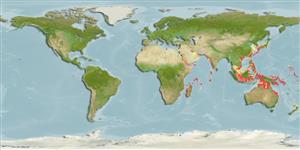>
Ophidiiformes (Cusk eels) >
Bythitidae (Livebearing brotulas)
Etymology: Microbrotula: Greek, mikros = small + Latin, brotula, -ae = little, bud, shoot (Ref. 45335); bentleyi: Named for Andrew Charles Bentley of Port Elizabeth, South Africa, now at the University of Kansas, USA, for his enthusiasm and help in the development of a program on western Indian Ocean fishes, and for collecting the holotype..
Environment: milieu / climate zone / depth range / distribution range
Écologie
marin récifal; profondeur 0 - 55 m (Ref. 54832). Tropical
Indo-Pacific: South Africa to the Red Sea and from the Philippines to Cape York Peninsula in northern Australia; widely distributed and large gap in the distribution is probably a collecting artefact rather than indicative of a true distribution.
Taille / Poids / Âge
Maturity: Lm ? range ? - ? cm
Max length : 4.0 cm SL mâle / non sexé; (Ref. 54832); 4.1 cm SL (female)
Description synthétique
Morphologie | Morphométrie
Rayons mous dorsaux (Total): 61-70; Rayons mous anaux: 50 - 57; Vertèbres: 44 - 47. This species is distinguished by the following characters: vertebrae 11-12+33-35=44-47; fin rays, on dorsal 61-70, anal 50-57, pectoral 15-17, caudal 7-8; anterior dorsal fin ray above vertebra number 7-8, anterior anal fin ray below dorsal fin ray number 12-16, anterior anal fin ray below vertebra 13-16; small forward-curved spine at lower angle of preopercle, hidden by skin; fleshy interorbital width 4.5-7.0% SL; palatine teeth papillae-like or absent (Ref. 88975).
Found from near the surface to 55 meters in protected reef structures (Ref. 54832). Solitary inhabitant of reef crevices, cryptic (Ref 90102).
Life cycle and mating behavior
Maturité | Reproduction | Frai | Œufs | Fécondité | Larves
Schwarzhans, W. and J.G. Nielsen, 2011. Revision of the genus Microbrotula (Teleostei: Bythitidae), with description of two new species and a related new genus. The Beagle, Records of the Museums and Art Galleries of the Northern Territory 27:147-160. (Ref. 88975)
Statut dans la liste rouge de l'IUCN (Ref. 130435)
Menace pour l'homme
Harmless
Utilisations par l'homme
Plus d'informations
Noms communsSynonymesMétabolismePrédateursÉcotoxicologieReproductionMaturitéFraiRassemblement de ponteFéconditéŒufsDéveloppement de l'œuf
Taille/ÂgeCroissanceLongueur-poidsLongueur-longueurFréquences de longueursMorphométrieMorphologieLarvesDynamique des populations larvairesRecrutementAbondanceBRUVS
RéférencesAquacultureProfil d'aquacultureSouchesGénétiqueElectrophoresesHéritabilitéPathologiesTraitementNutrientsMass conversion
CollaborateursImagesStamps, Coins Misc.SonsCiguateraVitesseType de nageSurface branchialeOtolithesCerveauxVision
Outils
Articles particuliers
Télécharger en XML
Sources Internet
Estimates based on models
Preferred temperature (Ref.
123201): 22.9 - 29, mean 27.5 °C (based on 576 cells).
Phylogenetic diversity index (Ref.
82804): PD
50 = 0.5039 [Uniqueness, from 0.5 = low to 2.0 = high].
Bayesian length-weight: a=0.00457 (0.00179 - 0.01169), b=3.10 (2.87 - 3.33), in cm total length, based on LWR estimates for this (Sub)family-body shape (Ref.
93245).
Niveau trophique (Ref.
69278): 3.2 ±0.5 se; based on size and trophs of closest relatives
Résilience (Ref.
120179): Haut, temps minimum de doublement de population inférieur à 15 mois (Preliminary K or Fecundity.).
Fishing Vulnerability (Ref.
59153): Low vulnerability (10 of 100).
